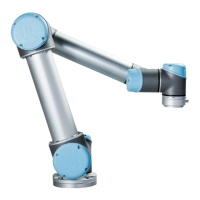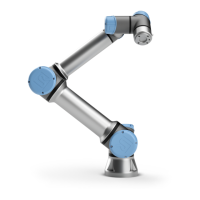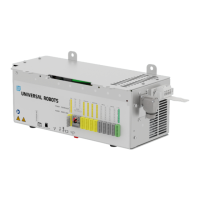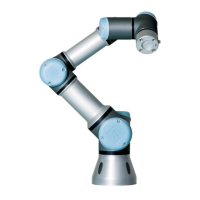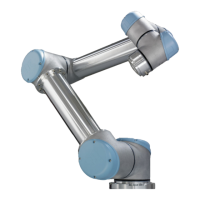10.12 Boundaries
When in Freedrive mode (see 13.1.5), and the current position of the robot TCP is close to a
safety plane, or the deviation of the orientation of the robot tool from the desired orientation is
close to the specified maximum deviation, the user will feel a repelling force which increases
in magnitude as the TCP approaches the limit. The force is generated when the TCP is within
approximately 5 cm of a safety plane, or the deviation of the orientation of the tool is approxi-
mately 3
◦
from the specified maximum deviation.
When a plane is defined as a Trigger Reduced mode plane and the TCP goes beyond this boundary,
the safety system transitions into Reduced mode which applies the Reduced mode safety settings.
Trigger planes follow the same rules as regular safety planes except they allow the robot arm to
pass through them.
10.12.1 Selecting a boundary to configure
The Safety Boundaries panel on the left side of the tab is used to select a boundary limit to
configure.
To set up a safety plane, click on one of the top eight entries listed in the panel. If the selected
safety plane has already been configured, the corresponding 3D representation of the plane is
highlighted in the 3D View (see 10.12.2) to the right of this panel. The safety plane can be set
up in the Safety Plane Properties section (see 10.12.3) at the bottom of the tab.
Click the Tool Boundary entry to configure the orientation boundary limit for the robot tool.
The configuration of the limit can be specified in the Tool Boundary Properties section
(see 10.12.4) at the bottom of the tab.
Click the
/ button to toggle the 3D visualization of the boundary limit on/off. If a bound-
ary limit is active, the safety mode (see 10.12.3 and 10.12.4) is indicated by one of the following
icons / / / .
10.12.2 3D visualization
The 3D View displays the configured safety planes and the orientation boundary limit for the
robot tool together with the current position of the robot arm. All configured boundary entries
where the visibility toggle is selected (i.e. showing icon) in the Safety Boundaries
section are displayed together with the current selected boundary limit.
The (active) safety planes are shown in yellow and black with a small arrow representing the
plane normal, which indicates the side of the plane on which the robot TCP is allowed to be po-
sitioned. Trigger planes are displayed in blue and green. A small arrow illustrates the side of the
plane that does not trigger the transition into Reduced mode. If a safety plane has been selected
in the panel on the left side of the tab, the corresponding 3D representation is highlighted.
The tool orientation boundary limit is visualized with a spherical cone together with a vector
indicating the current orientation of the robot tool. The inside of the cone represents the allowed
area for the tool orientation (vector).
When a plane or the tool orientation boundary limit is configured but not active, the visualiza-
tion is gray.
Push the magnifying glass icons to zoom in/out or drag a finger across to change the view.
Version 3.11
Copyright © 2009–2019 by Universal Robots A/S. All rights reserved.
II-13 e-Series

